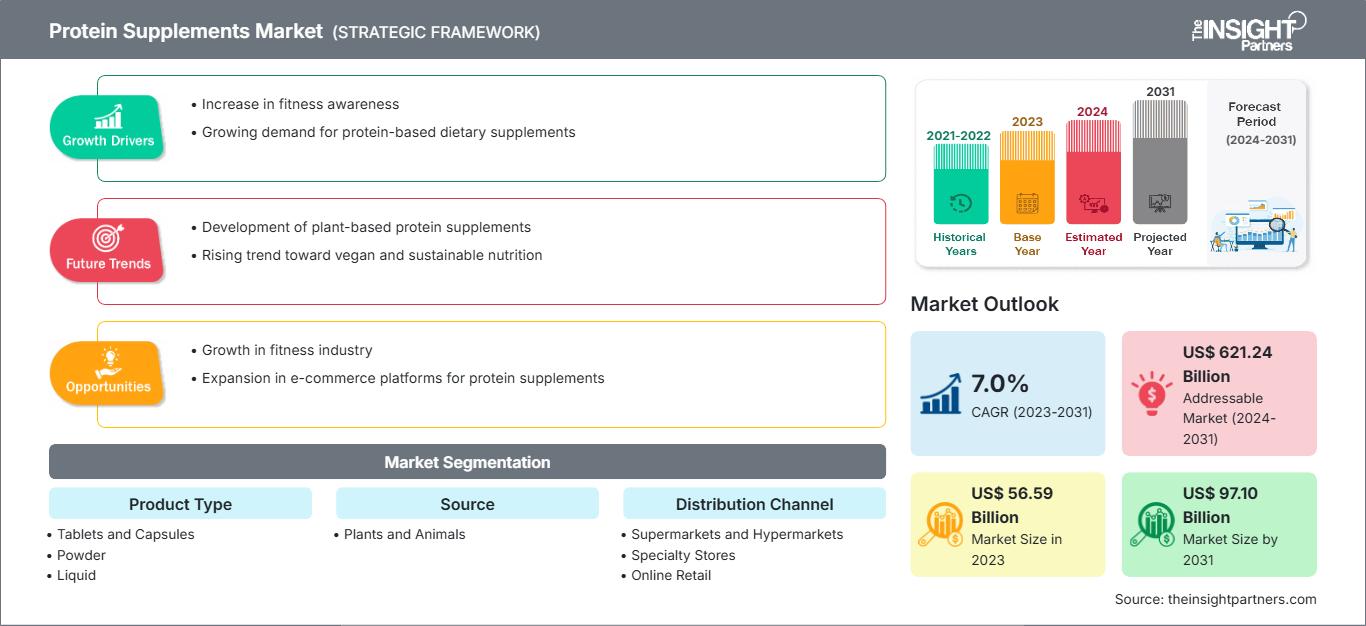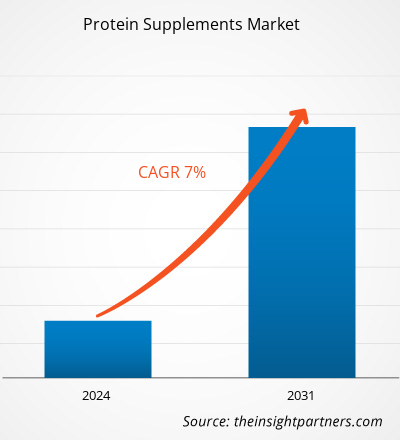The protein supplements market size is projected to reach US$ 97.10 billion by 2031 from US$ 56.59 billion in 2023. The market is expected to register a CAGR of 7.0% in 2023–2031. Increasing preference for personalized nutrition solutions and availability of customized protein supplements tailored to an individual’s health goal are likely to remain the key protein supplements market trends.
Protein Supplements Market Analysis
Protein supplements play an important role in meeting the daily protein requirements of an individual engaged in active lifestyle and sports. Protein supplements help in muscle recovery, and body toning, and promote muscle growth. The rising health awareness and increased participation in fitness and sports activities are driving the demand for protein supplements. Protein supplements such as protein powders, RTD protein shakes, and others also increase the endurance and overall performance of an athlete. These supplements also aid in weight loss and improve cardio performance. The growing inclination of people toward developing muscles is driving the growth of the protein supplements market. Moreover, the increasing number of participations in gyms, fitness centers, and yoga clubs is also driving the demand for protein supplements across the globe. Further, as veganism is surging, there is a strong growth potential for plant-based protein supplements, which is expected to open new growth opportunities in the coming years.
Protein Supplements Market Overview
Protein supplements help in fulfilling an individual’s protein requirements, usually to promote muscle growth, recovery, and overall wellness. They come in various forms, including tablets and capsules, powders, protein bars, and ready-to-drink protein shakes, each having its advantages. Protein powders are the most commonly available protein supplements, obtained from various sources including dairy and non-dairy based. Whey, casein, soy, and peas are the most widely used protein sources for manufacturing protein supplements. These powders are consumed by mixing with water or other beverages after working out to support muscle recovery or meet daily protein intake. Nowadays, innovative forms of protein supplements including protein bars and RTD protein shakes are becoming popular among consumers due to the variety of flavors and the convenience of consuming them on-the-go. Such products are expected to witness extensive consumer demand in the coming years.
Customize This Report To Suit Your Requirement
You will get customization on any report - free of charge - including parts of this report, or country-level analysis, Excel Data pack, as well as avail great offers and discounts for start-ups & universities
Protein Supplements Market: Strategic Insights

-
Get Top Key Market Trends of this report.This FREE sample will include data analysis, ranging from market trends to estimates and forecasts.
Protein Supplements Market Drivers and Opportunities
Rising Consumer Awareness Regarding Health and Nutrition to Favor Market
The growth of the protein supplements market is majorly driven by rising consumer awareness regarding health and fitness. As people become more health-conscious, the importance of protein in building muscle and post-workout recovery is increasing. Protein is a crucial nutrient for muscle maintenance, growth, and weight management. This has led to increased demand for protein supplements for fitness enthusiasts, athletes, sportsmen, and the general population. Due to the penetration of the internet and smartphones, people are spending more time online, browsing articles and blogs on fitness and diet which is also driving the demand for protein supplements, bolstering the market growth. Further, the rising influence of social media and celebrity-influenced fitness trends on the lifestyle of people along with increasing celebrity endorsements for protein supplement brands are favoring the growth of the protein supplements market.
Rapidly Expanding Consumer Base and Product Diversification – An Opportunity
The rising customer base and product innovation present significant growth opportunities for the protein supplements market. With expanding health-conscious individuals, there is a rising demand for customized protein supplements that fulfill different health goals of individuals. This creates opportunities for manufacturers of protein supplements to develop customized solutions to cater to different health requirements, such as personalized formulation. Moreover, with the booming e-commerce sector, companies are designing their direct-to-consumer websites that expand their customer reach and offer personalized shopping experiences, enhancing the market potential.
Protein Supplements Market Report Segmentation Analysis
Key segments that contributed to the derivation of the protein supplements market analysis are product type, source, and distribution channel.
- Based on product type, the protein supplements market is divided into tablets and capsules, powder, liquid, and others. The powder segment held a larger market share in 2023.
- By source, the market is segmented into plants and animals. The animals segment held the largest share of the market in 2023.
- In terms of distribution channel, the market is divided into supermarkets and hypermarkets, specialty stores, online retail, and others. The specialty stores segment dominated the market in 2023.
Protein Supplements Market Share Analysis by Geography
The geographic scope of the protein supplements market report is mainly divided into five regions: North America, Asia Pacific, Europe, Middle East & Africa, and South America/South & Central America.
North America dominated the global protein supplements market. Europe is a second major contributor, holding a significant global market share. Asia Pacific is expected to register a considerable CAGR during 2023–2031. North America has dominated the protein supplements market share in 2023. The emerging fitness and wellness culture in the US and Canada, majority of the population actively engaged in fitness activities, yoga, Pilates, bodybuilding, and sports, are driving the demand for protein supplements to support muscle growth and recovery. Additionally, the region’s well-developed sports nutrition industry and easy availability of health and fitness products have increased the access to protein supplements among consumers. Moreover, effective marketing strategies, including celebrity endorsements, and endorsements by sportsmen and athletes have further triggered the demand for protein supplements in North America. The stringent food and drug safety regulations in North America, especially in the US also contribute increased level of trust in the safety and effectiveness of protein supplements, driving market growth in the region.
Protein Supplements Market Regional InsightsThe regional trends and factors influencing the Protein Supplements Market throughout the forecast period have been thoroughly explained by the analysts at The Insight Partners. This section also discusses Protein Supplements Market segments and geography across North America, Europe, Asia Pacific, Middle East and Africa, and South and Central America.
Protein Supplements Market Report Scope
| Report Attribute | Details |
|---|---|
| Market size in 2023 | US$ 56.59 Billion |
| Market Size by 2031 | US$ 97.10 Billion |
| Global CAGR (2023 - 2031) | 7.0% |
| Historical Data | 2021-2022 |
| Forecast period | 2024-2031 |
| Segments Covered |
By Product Type
|
| Regions and Countries Covered |
North America
|
| Market leaders and key company profiles |
|
Protein Supplements Market Players Density: Understanding Its Impact on Business Dynamics
The Protein Supplements Market is growing rapidly, driven by increasing end-user demand due to factors such as evolving consumer preferences, technological advancements, and greater awareness of the product's benefits. As demand rises, businesses are expanding their offerings, innovating to meet consumer needs, and capitalizing on emerging trends, which further fuels market growth.

- Get the Protein Supplements Market top key players overview
Protein Supplements Market News and Recent Developments
The protein supplements market is evaluated by gathering qualitative and quantitative data post post-primary and secondary research, which includes important corporate publications, association data, and databases. The following is a list of developments in the market for speech and language disorders and strategies:
- Centrum, Multivitamin Brand marketed by Haleon (erstwhile GlaxoSmithKline Consumer Healthcare) announced the launch of Multivitamin & Protein Powders as an extension to its existing portfolio of tablets and gummies (Source: Nuffoods Spectrum, Press Release, 2023)
- Herbalife, a premier health and wellness company and community, announced today the launch of the Herbalife GLP-1 Nutrition Companion, a new range of food and supplement product combos fueled by the #1 Protein Shake in the World and intended to support the nutritional needs of individuals on GLP-1 and other weight-loss medications. Herbalife’s Classic and Vegan options are now available in the United States and Puerto Rico in a variety of flavors. (Herbalife, Press Release, 2024)
Protein Supplements Market Report Coverage and Deliverables
The “Protein Supplements Market Size and Forecast (2021–2031)” report provides a detailed analysis of the market covering below areas:
- Market size and forecast at global, regional, and country levels for all the key market segments covered under the scope
- Market dynamics such as drivers, restraints, and key opportunities
- Key future trends
- Detailed PEST/Porter’s Five Forces and SWOT analysis
- Global and regional market analysis covering key market trends, major players, regulations, and recent market developments
- Industry landscape and competition analysis covering market concentration, heat map analysis, prominent players, and recent developments
- Detailed company profiles
- Historical Analysis (2 Years), Base Year, Forecast (7 Years) with CAGR
- PEST and SWOT Analysis
- Market Size Value / Volume - Global, Regional, Country
- Industry and Competitive Landscape
- Excel Dataset
Recent Reports
Related Reports
Testimonials
Reason to Buy
- Informed Decision-Making
- Understanding Market Dynamics
- Competitive Analysis
- Identifying Emerging Markets
- Customer Insights
- Market Forecasts
- Risk Mitigation
- Boosting Operational Efficiency
- Strategic Planning
- Investment Justification
- Tracking Industry Innovations
- Aligning with Regulatory Trends





















 Get Free Sample For
Get Free Sample For